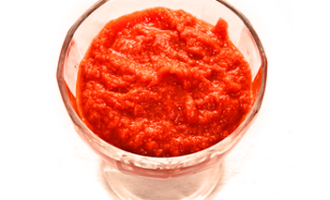The principle of cooking: ripe or overripe tomatoes are peeled and heavily boiled (1-2 hours) are laid out in jars. Cooking time for tomato paste depends on the juiciness of the tomatoes.
How to cook tomato paste
Recipe in a saucepan with a juicer
1 stage. Start of cooking. Put the pan (or several pots) on the stove, do not turn on the fire yet. Wash the tomatoes one by one, wipe dry, cut each in half and put the halves in a saucepan. Once the bottom of the pot is full, put it on medium heat and return to processing the tomatoes until they run out. After boiling under the tomatoes, reduce the heat, remove the foam.
Stage 2. Grinding and separating the juice from the cake – after half an hour of cooking, skip the brew through a juicer. A thick and tender paste requires separating the seeds and skins, so a juicer works best: it just won’t let them through, separating them into a pomace. If you want to deal with the preparation of pasta all the time, then it is best to buy a special wiping machine or a manual press. Manually separating the skins and grains is too time consuming.
Stage 3. The main cooking is the first 1-2 hours, while the tomatoes have a liquid consistency, occasionally stir with a wooden spatula, and when the paste has boiled down 2-3 times and becomes dense, continuously, and it is better to do this with gloves, as the paste gives hot spray.
Stage 4. Add salt and vinegar – optional, but for long-term storage in any conditions it is better to add. Be guided here by the taste of the tomatoes themselves, sweet varieties may require more salt for a balanced taste of the pasta. Standard proportions – for a 5-liter pan of fresh tomato 1 tablespoon of salt. Similarly with vinegar: for 1.5 liters of finished tomato paste, add 2-3 tablespoons of 6% vinegar 5 minutes before the end of cooking – for storage at room conditions.
Stage 5 Sterilization of jars and lids – for example, in a microwave or oven, bring the water in the jars to a boil, then drain the water.
Stage 6 Arrange the pasta in jars, close, roll up, cool and put away for storage.
Tasty Facts
Tomato paste is prepared for the future, as there are a lot of tomatoes in the season, and few or expensive in winter. In other words, they cook tomato paste to save money during the off-season. At the same time, just like ordinary tomatoes, tomato paste goes well with borscht, pasta, and also when preparing various sauces for hot dishes. Even if you just dilute tomato paste with water, you get tomato juice, no worse than store-bought.
It is better to take small jars for tomato paste: even a small jar of 100 milliliters is enough to cook 5 liters (large saucepan) of borscht or 2 glasses of juice. But after opening, it is recommended to store homemade tomato paste at a minimum, just a couple of days. Accordingly, large jars of tomato caviar should be prepared if you are a big tomato fan and are ready to drink borscht with tomato juice, having cooked pasta with stew for dinner.
Any ripe tomatoes are suitable for pasta: juicy ones should be inspected and blackouts cut out. Dense greenish tomatoes should be boiled with salt so that the pasta from them is better stored. Cooking time for tomato paste is to the desired consistency, as a rule, this is the consistency that corresponds to the name: a dense paste that does not subside and, moreover, does not drain from a spoon.
For reference, you can measure vegetables: from 10 kilograms of fresh tomatoes you get 1-1.5 liters of thick tomato paste.
It is possible to cook tomato paste without a juicer or a special press, but it is very time consuming: push the tomato puree through a sieve after half an hour of cooking. Put and tie puree in several layers of gauze, hang for several hours, boil for a couple of minutes and roll up.
If there is a juice cooker, then you can simmer the tomatoes in it for an hour, and only then pass through a sieve, boil for half an hour.
Store homemade tomato paste cooked without vinegar – in the refrigerator or freeze in ice packs. Just put the vinegar paste in a cool place.
